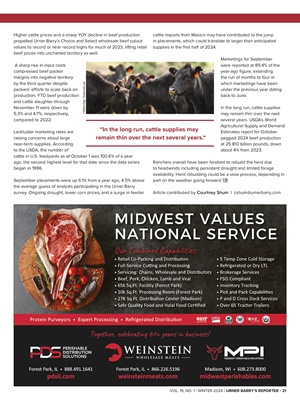
VOL. 19, NO. 1 / WINTER 2024 / URNER BARRY'S REPORTER • 21
Higher cattle prices and a sharp YOY decline in beef production
propelled Urner Barry's Choice and Select wholesale beef cutout
values to record or near record highs for much of 2023, lifting retail
beef prices into uncharted territory as well.
A sharp rise in input costs
compressed beef packer
margins into negative territory
by the third quarter despite
packers' efforts to scale back on
production. YTD beef production
and cattle slaughter through
November 11 were down by
5.3% and 4.7%, respectively,
compared to 2022.
Lackluster marketing rates are
raising concerns about large
near-term supplies. According
to the USDA, the number of
cattle in U.S. feedyards as of October 1 was 100.6% of a year
ago, the second highest level for that date since the data series
began in 1996.
September placements were up 6.1% from a year ago, 4.5% above
the average guess of analysts participating in the Urner Barry
survey. Ongoing drought, lower corn prices, and a surge in feeder
cattle imports from Mexico may have contributed to the jump
in placements, which could translate to larger than anticipated
supplies in the first half of 2024. Marketings for September
were reported at 89.4% of the
year-ago figure, extending
the run of months to four in
which marketings have been
under the previous year dating
back to June.
In the long run, cattle supplies
may remain thin over the next
several years. USDA's World
Agricultural Supply and Demand
Estimates report for October
pegged 2024 beef production
at 25.810 billion pounds, down
about 4% from 2023.
Ranchers overall have been hesitant to rebuild the herd due
to headwinds including persistent drought and limited forage
availability. Herd rebuilding could be a slow process, depending in
part on the weather going forward.
Article contributed by Courtney Shum | cshum@urnerbarry.com
©William Edge / Shutterstock.com
"In the long run, cattle supplies may
remain thin over the next several years."